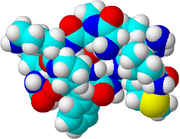Substance P
| tachykinin, precursor 1 | |
|---|---|

Spacefilling model of substance P
|
|
| Identifiers | |
| Symbol | TAC1 |
| Alt. symbols | TAC2, NKNA |
| Entrez | 6863 |
| HUGO | 11517 |
| OMIM | 162320 |
| RefSeq | NM_003182 |
| UniProt | P20366 |
| Other data | |
| Locus | Chr. 7 q21-q22 |
 |
|
| Identifiers | |
|---|---|
|
33507-63-0 |
|
| ChEMBL |
ChEMBL235363 |
| ChemSpider |
33558 |
| ECHA InfoCard | 100.046.845 |
| 2098 | |
| MeSH | Substance+P |
| PubChem | 36511 |
| UNII |
675VGV5J1D |
|
|
| Properties | |
| C63H98N18O13S | |
| Molar mass | 1347.63 g/mol |
|
Except where otherwise noted, data are given for materials in their standard state (at 25 °C [77 °F], 100 kPa).
|
|
|
|
|
| Infobox references | |
Substance P (SP) is an undecapeptide (a peptide composed of a chain of 11 amino acid residues) member of the tachykinin neuropeptide family. It is a neuropeptide, acting as a neurotransmitter and as a neuromodulator. Substance P and its closely related neurokinin A (NKA) are produced from a polyprotein precursor after differential splicing of the preprotachykinin A gene. The deduced amino acid sequence of substance P is as follows:
with an amidation at the C-terminus. Substance P is released from the terminals of specific sensory nerves. It is found in the brain and spinal cord and is associated with inflammatory processes and pain.
The original discovery of Substance P (SP) was in 1931 by Ulf von Euler and John H. Gaddum as a tissue extract that caused intestinal contraction in vitro. Its tissue distribution and biologic actions were further investigated over the following decades. The eleven-amino-acid structure of the peptide was determined by Susan Leeman in 1971.
In 1983, NKA (previously known as substance K or neuromedin L) was isolated from porcine spinal cord and was also found to stimulate intestinal contraction.
The endogenous receptor for substance P is neurokinin 1 receptor (NK1-receptor, NK1R). It belongs to the tachykinin receptor sub-family of GPCRs. Other neurokinin subtypes and neurokinin receptors that interact with SP have been reported as well. Amino acid residues that are responsible for the binding of SP and its antagonists are present in the extracellular loops and transmembrane regions of NK-1. Binding of SP to NK-1 results in internalization by the clathrin-dependent mechanism to the acidified endosomes where the complex disassociates. Subsequently, SP is degraded and NK-1 is re-expressed on the cell surface. Substance P and the NK1 receptor are widely distributed in the brain and are found in brain regions that are specific to regulating emotion (hypothalamus, amygdala, and the periaqueductal gray). They are found in close association with serotonin (5-HT) and neurons containing norepinephrine that are targeted by the currently used antidepressant drugs. The SP receptor promoter contains regions that are sensitive to cAMP, AP-1, AP-4, CEBPB, and epidermal growth factor. Because these regions are related to complexed signal transduction pathways mediated by cytokines, it has been proposed that cytokines and neurotropic factors can induce NK-1. Also, SP can induce the cytokines that are capable of inducing NK-1 transcription factors.
...
Wikipedia
